Intel Core i7 3960X (Sandy Bridge E) Review: Keeping the High End Alive
by Anand Lal Shimpi on November 14, 2011 3:01 AM EST- Posted in
- CPUs
- Intel
- Core i7
- Sandy Bridge
- Sandy Bridge E
Windows 7 Application Performance
3dsmax 9
Today's desktop processors are more than fast enough to do professional level 3D rendering at home. To look at performance under 3dsmax we ran the SPECapc 3dsmax 8 benchmark (only the CPU rendering tests) under 3dsmax 9 SP1. The results reported are the rendering composite scores.
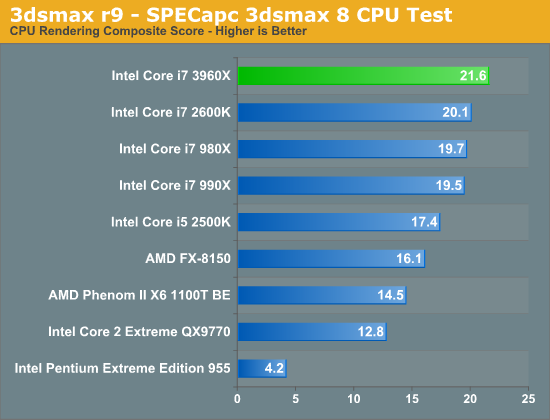
Offline 3D rendering applications make some of the best use of CPU cores, unfortunately our test here doesn't scale all that well. We only see a 7% increase over the 2600K. If we look at a more modern 3D workload however...
Cinebench 11.5
Created by the Cinema 4D folks we have Cinebench, a popular 3D rendering benchmark that gives us both single and multi-threaded 3D rendering results.
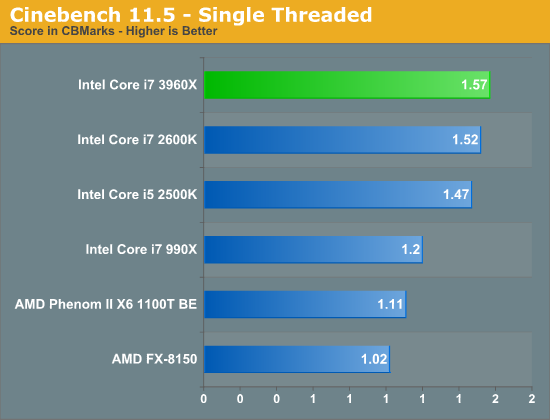
Single threaded performance is marginally better than the 2600K thanks to the 3960X's slightly higher max turbo speed. What's more important than the performance here is the fact that the 3960X is able to properly power gate all idle cores and give a single core full reign of the chip's TDP. Turbo is alive and well in SNB-E, just as it was in Sandy Bridge.
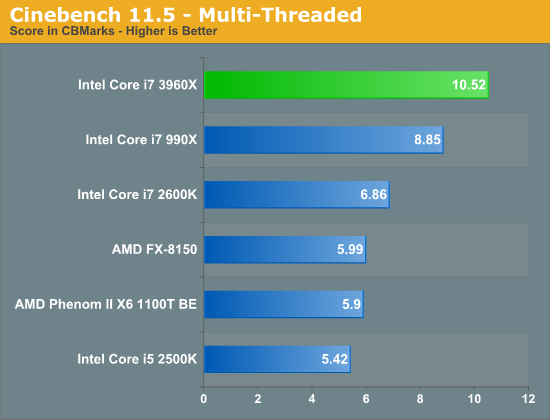
Here the performance gains are staggering. The 3960X is 53% faster than the 2600K and 19% faster than Intel's previous 6-core flagship, the 990X. The Bulldozer comparison is almost unfair, the 3960X is 75% faster (granted it is also multiple times the price of the FX-8150).
7-Zip Benchmark
While Cinebench shows us multithreaded floating point performance, the 7-zip benchmark gives us an indication of multithreaded integer performance:

Here we see huge gains over the 2600K (58%), indicating that the increase in cache size and memory bandwidth help the boost in core count a bit here. The advantage over the 990X is only 7%. This gives us a bit of a preview of what we can expect from SNB-EP Xeon server performance.
PAR2 Benchmark
Par2 is an application used for reconstructing downloaded archives. It can generate parity data from a given archive and later use it to recover the archive
Chuchusoft took the source code of par2cmdline 0.4 and parallelized it using Intel’s Threading Building Blocks 2.1. The result is a version of par2cmdline that can spawn multiple threads to repair par2 archives. For this test we took a 708MB archive, corrupted nearly 60MB of it, and used the multithreaded par2cmdline to recover it. The scores reported are the repair and recover time in seconds.
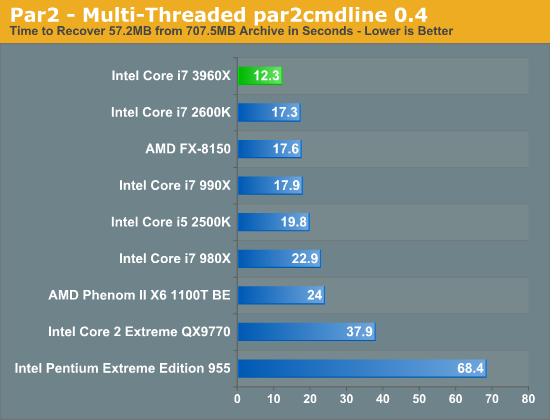
Here we see a 40% increase in performance over the 2600K and FX-8150.
TrueCrypt Benchmark
TrueCrypt is a very popular encryption package that offers full AES-NI support. The application also features a built-in encryption benchmark that we can use to measure CPU performance with:
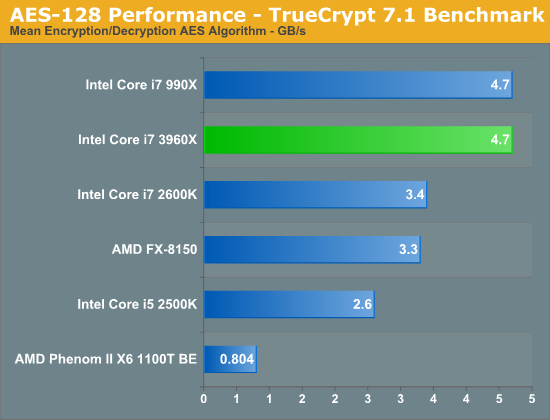
As both the 990X and 3960X have AES-NI support, both are equally capable at cranking through an AES workload. Per core performance doesn't appear to have changed all that much with the move to Sandy Bridge, so here we have a situation where the 3960X is much faster than the 2600K but no faster than the 990X. I suspect these types of scenarios will be fairly rare.
x264 HD 3.03 Benchmark
Graysky's x264 HD test uses x264 to encode a 4Mbps 720p MPEG-2 source. The focus here is on quality rather than speed, thus the benchmark uses a 2-pass encode and reports the average frame rate in each pass.
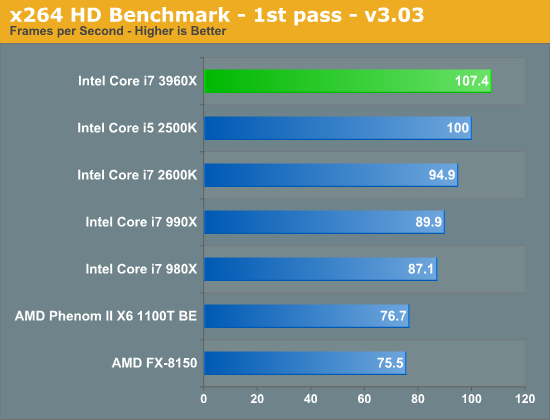
Single threaded performance isn't significantly faster than your run-of-the-mill Sandy Bridge, which means the first x264 HD pass doesn't look all that impressive on SNB-E.
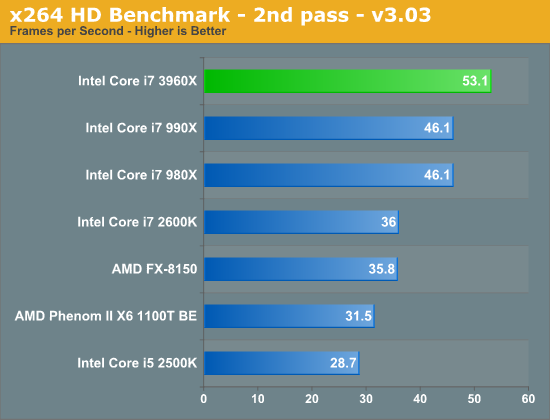
The second pass however stresses all six cores far more readily, resulting in a 47.5% increase in performance over the 2600K. Even compared to the 990X there's a 15% increase in performance.
Adobe Photoshop CS4
To measure performance under Photoshop CS4 we turn to the Retouch Artists’ Speed Test. The test does basic photo editing; there are a couple of color space conversions, many layer creations, color curve adjustment, image and canvas size adjustment, unsharp mask, and finally a gaussian blur performed on the entire image.
The whole process is timed and thanks to the use of Intel's X25-M SSD as our test bed hard drive, performance is far more predictable than back when we used to test on mechanical disks.
Time is reported in seconds and the lower numbers mean better performance. The test is multithreaded and can hit all four cores in a quad-core machine.
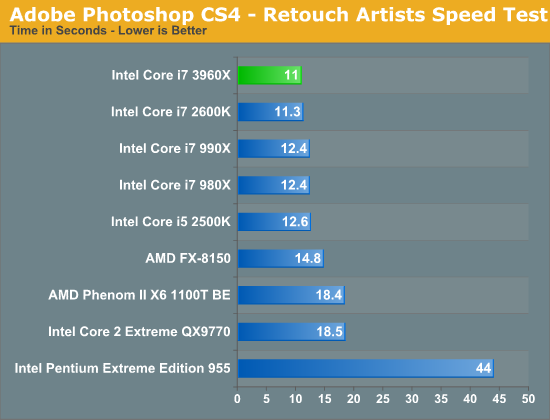
Our Photoshop test is multithreaded but there are only spikes that use more than four cores. That combined with the short duration of the benchmark shows no real advantage to the 3960X over the 2600K. Sandy Bridge E is faster than Intel's old 6-core solution though.
Compile Chromium Test
You guys asked for it and finally I have something I feel is a good software build test. Using Visual Studio 2008 I'm compiling Chromium. It's a pretty huge project that takes over forty minutes to compile from the command line on the Core i3 2100. But the results are repeatable and the compile process will stress all 12 threads at 100% for almost the entire time on a 980X so it works for me.
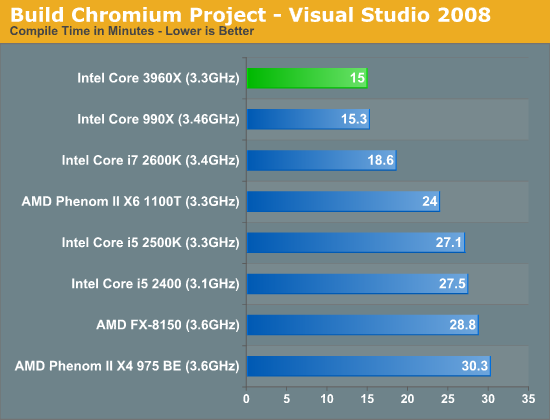
Our compile test is extremely well threaded, which once again does well on the 3960X. The gains aren't as big as what we saw in some of our earlier 3D/transcoding tests, but if you're looking to build the fastest development workstation you'll want a Sandy Bridge E.
Excel Monte Carlo
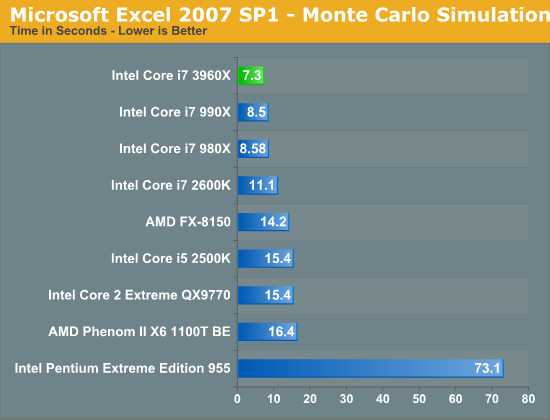
Multithreaded compute does well on SNB-E regardless of the type of application. Excel is multithreaded and if you have a beefy enough workload, you'll see huge gains over the 2600K.










163 Comments
View All Comments
DanNeely - Monday, November 14, 2011 - link
AMD's been selling 6 core Phenom CPUs since April 2010 (6 core opterons launched in jun 09). Prior to SB's launch they were very competitive with intel systems at the same mobo+CPU price points, and while having fallen behind since then are still decent buys for more threaded apps because AMD's slashed prices to compete.On the intel side, while hyperthreading isn't 8 real cores for most workloads 8 threads will run significantly faster than 4.
ClagMaster - Monday, November 14, 2011 - link
This Sandy-Bridge-E is really a desktop supercomputer well-suited for engineering workstations that can solve Abequs or Monte Carlo Programs. With that intent, the Xeon brand of this processor, with eight-cores and ECC memory support, is the processor to buy.The Xeon will very likely have the SAS support that Anand so laments on a specialty chipset based on the X79. And engineering workstations are not made or broken with lack of native USB 3 controllers.
DDR3 1333 is not slouch memory. With four channels of the memory there will be much faster memory IO than a two channel system on the i7-2700K with the same memory.
This Sandy-Bridge-E consumer chip is for those true, frothing, narcisstic enthusiasts who have thousands of USD to burn and want the bragging rights.
I suppose its their money to waste and their chests to thump.
As for myself, I would have purchased an ASUS C206 workstation and a E3-1240 Xeon processor.
sylar365 - Monday, November 14, 2011 - link
Everybody is seeing the benchmarks and claiming that this processor is overkill for gaming but aren't all of these "real world" gaming benchmarks run with the game as being the ONLY application open at the time of testing? I understand that you need to reduce the number of variables in order to produce accurate numbers across multiple platforms, but what I really want to know, more than "can it run (insert game) at 60fps" is this:Can it run (for instance) Battlefield 3 multiplayer on "High" ALONGSIDE Origin, Chrome, Skype, Pandora One and streaming software while giving a decent stream quality?
Streaming gameplay has become popular. Justin.tv has made Twitch.tv as a separate site just to handle all of the gamers streaming themselves in gameplay. Streaming software such as Xsplit Broadcaster are doing REAL TIME video encoding of screen captures or Gamesource and then bundling for streaming all in one swoop and ALL WHILE PLAYING THE GAME AT THE SAME TIME. For streamers who count on ad revenue as a source of income it becomes less about Time = Money and more about Quality = Money since everything is required to happen in real time. I happen to know for a fact that a 2500k @ 4.0Ghz chokes on these tasks and it directly impacts the quality of the streaming experience. Don't even get me started on trying to stream Skyrim at 720p, a game that actually taxes the processor. What is the point of running a game at it's highest possible settings at 60fps if the people watching only see something like a watercolor re-imagining at the other end? Once you hurdle bandwidth contraints and networking issues the stream quality is nearly 100% dependent on the processor and it's immediate subsystem. Video cards need not apply here.
There has got to be a way to determine if multiple programs can be run in different threads efficiently on these modern processors. Or at least a way to see whether or not there would be an advantage to having a 3960x over a 2500k in a situation like I am describing. And I know I can't be the only person who is running more than one program at a time. (Am I?) I mean, I understand that some applications are not coded to benefit from more than one core, but can multi-core or multi-threaded processors even help in situations where you are actually using more than one single threaded (or multi-threaded) application at a time? What would the impact of quad-channel memory be when, heaven forbid, TWO taxing applications are being run at the SAME TIME!? GASP!
N4g4rok - Monday, November 14, 2011 - link
That's a good point, but don't forget that a lot of games are so CPU intensive that it would take more than just background applications to cause the CPU to lose it's performance during gameplay. I can't agree with the statement that streaming video will be completely dependent on the processor. The right software will support hardware acceleration, and would likely tax the GPU just as much as the CPU.However, with this processor, and a lot of Intel processors with hyper-threading, you would be sacrificing just a little bit of it's turbo frequency to deal with those background applications. Which should not be a problem for this system.
Also, keep in mind that benchmarks are just trying to give a general case. if you know how well one application runs, and you know how well another runs, you should be able to come up with a rough idea of how it will handle both of those tasks at the same time. and it's likely that the system running these games is also running necessary background software. you can assume things like Intel's Turbo Boost controller or the GPU driver software, etc. etc.
N4g4rok - Monday, November 14, 2011 - link
"but don't forget that a lot of games are so CPU intensive that it would take more than...."My mistake, i meant 'GPU' here.
sylar365 - Monday, November 14, 2011 - link
"The right software will support hardware acceleration, and would likely tax the GPU just as much as the CPU"In almost every modern game I wouldn't want my streaming software to utilize the GPU(s) since it is already being fully utilized to make the game run smoothly. Besides, most streaming software I know of doesn't even have the option to use that hardware yet. If it did I suppose you could start looking at Tesla cards just to help process the conversion and encoding of stream video, but then you are talking about multiple thousands of dollars just for the Tesla hardware. You should check out Tom's own BF3 performance review and see how much GPU compute power would be left after getting a smooth experience at 1080p for the local machine. It seems like the 3960x could help. But I will evidently need to take the gamble of spending $xxxx myself since I don't get hardware sent to me for review and no review sites are posting any type of results for using two power hungry applications at the same time.
N4g4rok - Tuesday, November 15, 2011 - link
No kidding.Even with it's performance, it's difficult to justify that price.
shady28 - Monday, November 14, 2011 - link
Could rename this article 'Core i7 3960X - Diminishing Returns'
Not impressed at all with this new chip. Maybe if you're doing a ton of multitasking all time time (like constantly doing background decoding) it would be worth it, but even in the multitasking benchmarks it isn't exactly revolutionary.
If multitasking is that big of a deal, better off getting a G34 and popping in a pair of 8 or 12 core Magny Cours AMD's. Or, maybe the new 16 Interlagos core G34. Heck, the 16 core is selling for $650 at NewEgg already.
For anything else, it's really only marginally faster while probably being considerably more expensive.
Bochi - Monday, November 14, 2011 - link
Can we get benchmarks that show the potential impact of the greater CPU power & memory bandwidth? This may be overkill for gaming at 1920 x 1080. However, I would like to know what type of performance changes are possible when it's used on a top end Crossfire or SLI system.rs2 - Monday, November 14, 2011 - link
"I had to increase core voltage from 1.104V to 1.44V, but the system was stable."Surely that is a typo?